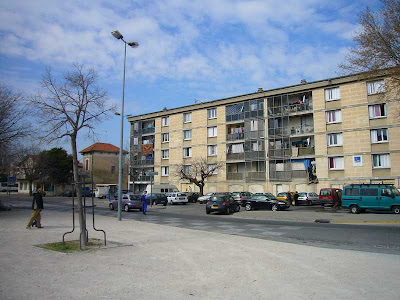
Street performance art is always happening along La Rambla, like this young woman dressed up as a sunflower. Sometimes it was "still art" like this one, other times it was a regular show.
 Las Boquerias is the neighborhood market adjacent to La Rambla. Much like many of the covered markets we have seen, but a cut above because of all the traffic. Spices sold out of gunny sacks just like we see in the Guatemalan markets. Easy to spend a day in this market!
Las Boquerias is the neighborhood market adjacent to La Rambla. Much like many of the covered markets we have seen, but a cut above because of all the traffic. Spices sold out of gunny sacks just like we see in the Guatemalan markets. Easy to spend a day in this market!
 I think Paris is more walkable than Barcelona (but not by much), but Barcelona excells in architectural flourishes. If you can blow this picture up, you can see a lot of great detail on an otherwise mundane structure.
I think Paris is more walkable than Barcelona (but not by much), but Barcelona excells in architectural flourishes. If you can blow this picture up, you can see a lot of great detail on an otherwise mundane structure.
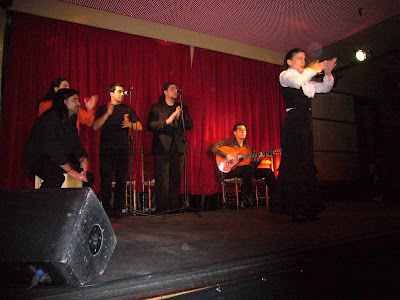 Barcelona is not known for its flamenco music--but it IS Spain--so Flamenco was there to be had and this was a great performance--very intense!
Barcelona is not known for its flamenco music--but it IS Spain--so Flamenco was there to be had and this was a great performance--very intense!
These little delicacies are called "montaditas". They are somewhat like Tapas, but usually on bread like a little sandwich. You take as many as you want, but you keep the toothpicks and thats how they charge you. A different kind of "fast food".
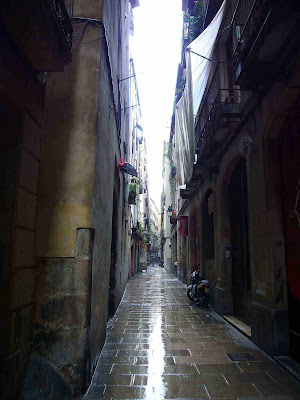 A typical narrow street in the old city (Barri Gotic). This one is mainly residential. The streets with stores in this part of the city were just a bit wider.
A typical narrow street in the old city (Barri Gotic). This one is mainly residential. The streets with stores in this part of the city were just a bit wider.
Even in the dense old city, there are little parks everywhere.

Here is dessert from one of our more memorable meals dining on Catalan cuisine. This is a different variety of Pain Chocolat that we had seen in France. This is a piece of bread (a baguette or pan frances) with a thick slice of dark chocolate just slightly warmed at melted, lightly doused with olive oil and a pinch or two of salt. Very different--but quite good!
 The famous Sagrada Familia church--a growing masterpiece still under construction. Started by Antonio Gaudi almost 100 years ago. This is about the most impressive church I have ever seen. No pictures (of mine anyway) can do it justice.
The famous Sagrada Familia church--a growing masterpiece still under construction. Started by Antonio Gaudi almost 100 years ago. This is about the most impressive church I have ever seen. No pictures (of mine anyway) can do it justice.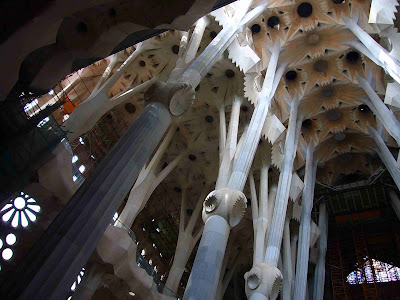 This is the best I can do for the inside of this cathedral. These pillars are stone--not poured concrete. The play of light in this church is quite different from that of other cathedrals. There is a real sense of the divine here. Construction is starting to speed up, so perhaps they will finish it within a generation....
This is the best I can do for the inside of this cathedral. These pillars are stone--not poured concrete. The play of light in this church is quite different from that of other cathedrals. There is a real sense of the divine here. Construction is starting to speed up, so perhaps they will finish it within a generation....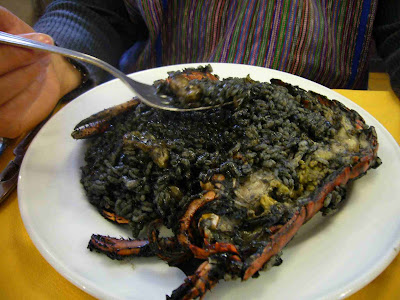
Another Catalan dining adventure--Black Rice (with lobster). A Catalan seafood tradition. Not black beans and rice--but BLACK RICE. The rice is colored and cooked in the black ink of the squid. Very unique!
 My favorite plaza in a city of plazas--Plaza Real. Very simple--just the way it should be. All the elements are here--eyes on the plaza, pedestrian access and scale, surrounded by restaurants etc. Even on this cold and rainy day a fair amount of people enjoying the plaza.
My favorite plaza in a city of plazas--Plaza Real. Very simple--just the way it should be. All the elements are here--eyes on the plaza, pedestrian access and scale, surrounded by restaurants etc. Even on this cold and rainy day a fair amount of people enjoying the plaza. Street with stores in the old city or Barri Gotic de Barcelona. It is rainy and cold--and still crowded! Thats what the right kind of city design does for you!
Street with stores in the old city or Barri Gotic de Barcelona. It is rainy and cold--and still crowded! Thats what the right kind of city design does for you!
Outside of the old city, this is what a great deal of Barcelona looks like. Mid-rise living just about everywhere. Close packed--but all walkable with stores and restaurants nearby.
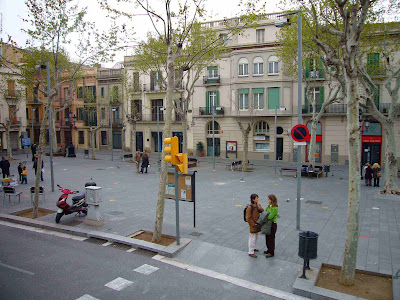 All of these dense neighborhoods appear to have little plazas and parks like these everywhere. Real gathering places!
All of these dense neighborhoods appear to have little plazas and parks like these everywhere. Real gathering places! From Nimes we took our last drive south to Collioure--about a 2.5 hour drive on the EU tollways. The Camargue is just south of Nimes.
From Nimes we took our last drive south to Collioure--about a 2.5 hour drive on the EU tollways. The Camargue is just south of Nimes.

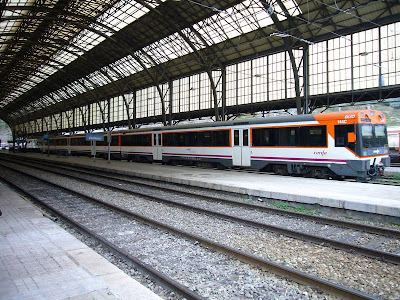 The train station at Port Bou, Spain, where we had to change trains. This is the train that took us into Barcelona--about the same as the one that brought us from Collioure to this point. (Notice that is is electric--it merges in with the Barcelona metro much as the French RER in Paris).
The train station at Port Bou, Spain, where we had to change trains. This is the train that took us into Barcelona--about the same as the one that brought us from Collioure to this point. (Notice that is is electric--it merges in with the Barcelona metro much as the French RER in Paris).
 Wonderful, walkable streets in the old city with architecture reminisence of Paris. Lots of restaurants, lots of shopping.
Wonderful, walkable streets in the old city with architecture reminisence of Paris. Lots of restaurants, lots of shopping.
 I took this shot of the bus routes on a bus stop in the old city. Amazing coverage for a city of 130,000! Bryan-College Station just a little bit smaller--a system like this is unimaginable in a Texas city of this size. You have to have density to support something like this.
I took this shot of the bus routes on a bus stop in the old city. Amazing coverage for a city of 130,000! Bryan-College Station just a little bit smaller--a system like this is unimaginable in a Texas city of this size. You have to have density to support something like this. As most cities in this area, Nimes has a wonderful covered market. But couldn't they have done something more interesting with that facade?? Right in the heart of the old city--what an architectural violation. But inside--its another story!
As most cities in this area, Nimes has a wonderful covered market. But couldn't they have done something more interesting with that facade?? Right in the heart of the old city--what an architectural violation. But inside--its another story!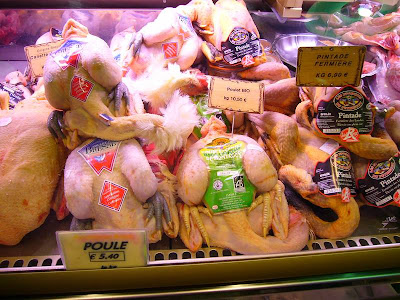
 This covered market merges into a shopping mall very similar in many respects to our own shopping malls--with some important exceptions, like this jack of all trades repair shop. The gentleman is working on a pair of shoes in this picture but you can see that he also works on bicycle tires among other things. A great example of the way small local businesses seem to survive a bit better in France.
This covered market merges into a shopping mall very similar in many respects to our own shopping malls--with some important exceptions, like this jack of all trades repair shop. The gentleman is working on a pair of shoes in this picture but you can see that he also works on bicycle tires among other things. A great example of the way small local businesses seem to survive a bit better in France.


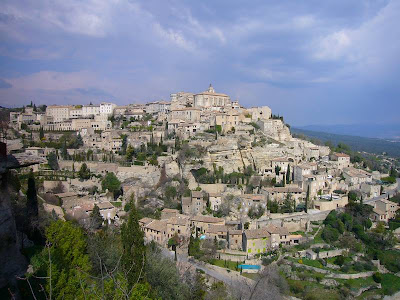

 The Camargue wetlands are pretty wet--as you might expect. There are a whole range of wetland types that we were able to observe on our drive through the Camargue. This area feels very much like the Texas coastal prairie--and I have seen the Camarge referred as the French Texas.
The Camargue wetlands are pretty wet--as you might expect. There are a whole range of wetland types that we were able to observe on our drive through the Camargue. This area feels very much like the Texas coastal prairie--and I have seen the Camarge referred as the French Texas.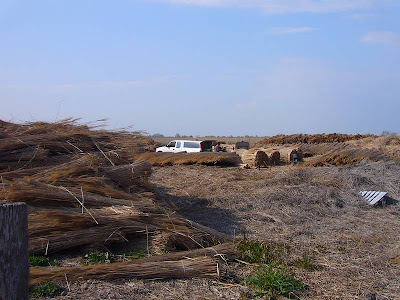

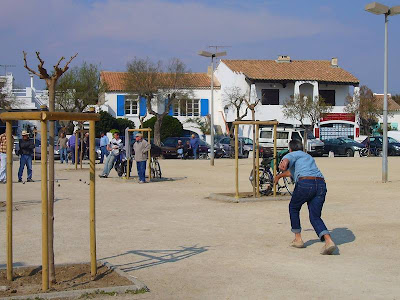 Les Stes Maries de la Mer is a very interesting little town on the ocean edge of the Camargue. Great little squares and parks and perfect pedestrian scale. This was on a late Wednesday afternoon in the main square--a leisurely game that appears to be a cross between bowling, croquet, and marbles. Both men and women were playing, and of various ages. I believe this game is played in other parts of France as well but I don't know the name. A venue for real social capital to develop!
Les Stes Maries de la Mer is a very interesting little town on the ocean edge of the Camargue. Great little squares and parks and perfect pedestrian scale. This was on a late Wednesday afternoon in the main square--a leisurely game that appears to be a cross between bowling, croquet, and marbles. Both men and women were playing, and of various ages. I believe this game is played in other parts of France as well but I don't know the name. A venue for real social capital to develop!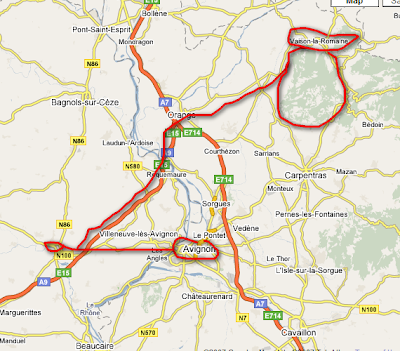

 First thing I noticed about this landscape was just a similar it is to the Texas Hill Country--with the exception of the ancient olive trees of course. White and red oaks, yaupon-like hollies, etc etc. The Garrigue is the local name for the shrub-scrub landscape that has resulted from milenia of human management.
First thing I noticed about this landscape was just a similar it is to the Texas Hill Country--with the exception of the ancient olive trees of course. White and red oaks, yaupon-like hollies, etc etc. The Garrigue is the local name for the shrub-scrub landscape that has resulted from milenia of human management.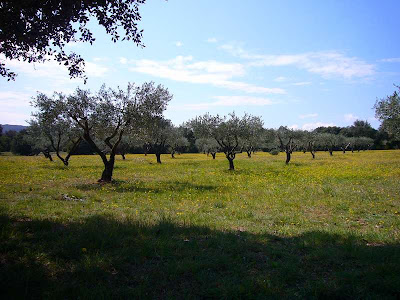


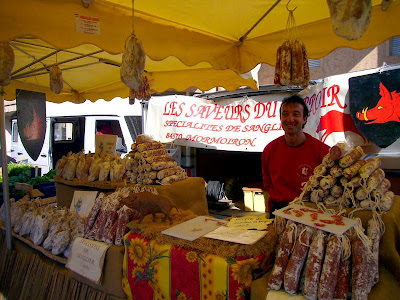
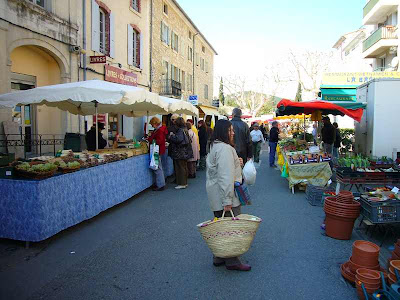
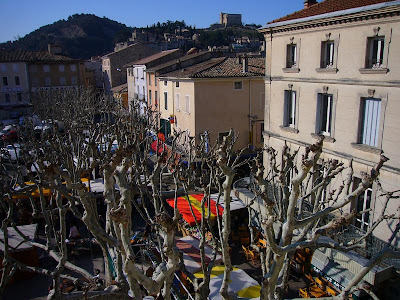 The view from our room in Vaisson on market day morning. Below are butchered plane trees and market stalls. Above is the old walled town and the castle or chateaux.
The view from our room in Vaisson on market day morning. Below are butchered plane trees and market stalls. Above is the old walled town and the castle or chateaux.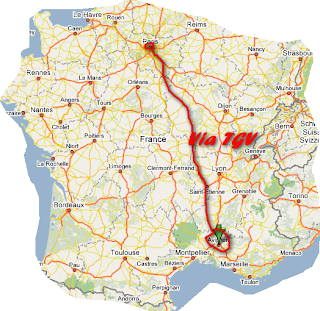
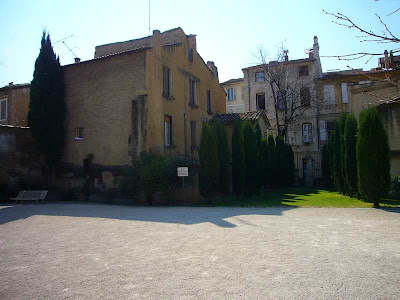
 Here is a nice aerial that shows up on windows live local. The arrow shows our hotel and you can see the little park.
Here is a nice aerial that shows up on windows live local. The arrow shows our hotel and you can see the little park. This is the covered market (less Halles) on the Sunday morning we were there. This aint no Walmart, folks. Local people selling local goods! A real smorgasboard of good stuff. And lots of local interaction going on as well.
This is the covered market (less Halles) on the Sunday morning we were there. This aint no Walmart, folks. Local people selling local goods! A real smorgasboard of good stuff. And lots of local interaction going on as well.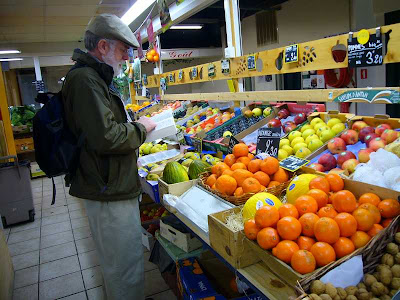
 Leticia just outside the market in one of the many squares that dot Avignon. No lack of public civic space!
Leticia just outside the market in one of the many squares that dot Avignon. No lack of public civic space!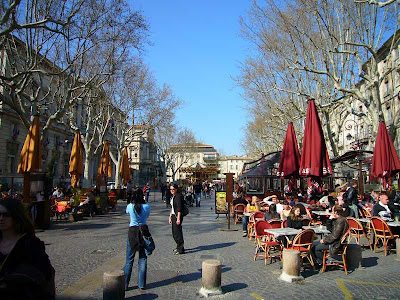
 A windows live local view of the same shot from above, showing location and direction. Could there be a better demonstration of how density helps make a place?
A windows live local view of the same shot from above, showing location and direction. Could there be a better demonstration of how density helps make a place?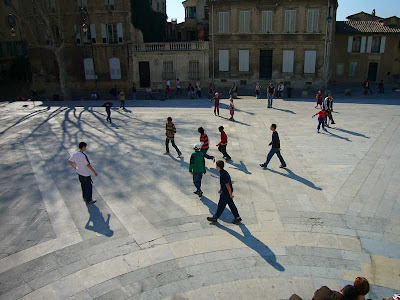 This is a small square just off of one of the "main" squares of Avignon. When you see kids playing in the square (there is a soccer ball in there somewhere!), you know the design is right!
This is a small square just off of one of the "main" squares of Avignon. When you see kids playing in the square (there is a soccer ball in there somewhere!), you know the design is right!